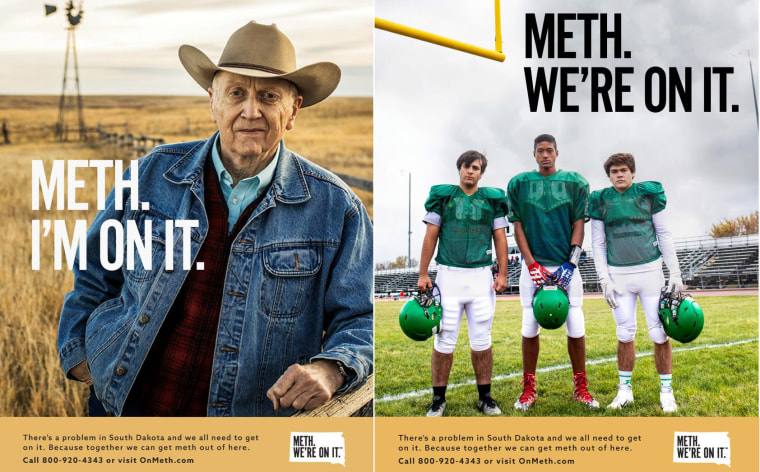South Dakota’s new anti-methamphetamine campaign, “Meth. We’re on it,” was widely mocked on the internet, as people tried to figure out if the state was tackling the meth crisis or using the drug.
But jokes aside, South Dakotan health experts and government officials want the escalating meth crisis— one they say is ravaging their rural state — to be taken seriously. Gov. Kristi Noem took to Twitter Tuesday to defend her administration’s campaign, emphasizing that "meth is a serious problem in SD."
In South Dakota, twice as many teenagers ages 12 to 17 reported using meth in the past year than the national average, Laurie Gill, the state’s Department of Social Services Secretary, told NBC News. Even more, 83 percent of court admissions for controlled substances in 2019 involved meth, and between 2014 and 2018, the state saw a 200 percent increase in people seeking treatment with the primary diagnosis of meth addiction.
“South Dakota’s meth crisis is growing and it is alarming,” Gill said. It's hitting every corner of the state. It’s why her office launched the awareness campaign, and why she is glad people are talking about it, even if they’re making jokes.
Meth has been around for a while, but its trending upwards in South Dakota, and throughout states west of the Mississippi, Dr. Wilson Compton, deputy director of the National Institute on Drug Abuse, told NBC News. As people get attuned to the opioid crisis and money is being spent to tackle opioid use, in places like Rapid City, South Dakota’s second most populous city, meth is sneaking up on residents.
“Ten to 15 years ago when an officer found someone with meth on them, it was the talk of the department. It was very noteworthy,” Officer Brendyn Medina of the Rapid City police said. “Now, it’s commonplace to find meth on the people we are called to interact with.”
Drugs arrests were at an all-time high in Rapid City in 2018: 1,546 for a city of around 75,000. “It’s probably the number one public safety epidemic facing the city, the state, and much of the Midwest,” Medina said, adding that meth use has a “nexus with violent crime.” Meth use is so common in Rapid City it has almost become normalized, Medina said.
South Dakota, like many of its neighboring states, is struggling as a result. Meth is filling up the jails, straining law enforcement, keeping the court schedules packed, and stretching drug treatment centers, which often now have long wait times for those seeking help.
“It’s destroying people and families,” Gill said, but not everyone realizes its impact and the funds aren’t there to adequately tackle the crisis.
Meth is highly addictive, and health officials are seeing increasing overlap with opioid and meth use, Dr. Compton said. The drug’s rise is partly due to the ease with which you can make it, and how cheap it is.
Treatment for meth, too, is difficult. There are currently no medications for people trying to get off meth, and treatment relies on behavioral approaches that can be timely, Compton said. And meth tends to be more common in rural places, like South Dakota, where people might have more limited access to healthcare. Currently, there’s federal funding to tackle opioid addiction, but scant federal money for meth, Gill said.
“Meth. We’re on it,” is one aspect of what state officials say is their multi-pronged approach to mitigating meth use — it’s meant to get people talking and make sure people know what’s happening in their own backyard. Gill said her office is trying to launch a middle school education program, and state university researchers developed a drug monitoring program that provides clearer data about where drugs are being used in the state and where resources are needed.
Dr. John Korkow, assistant professor in the department of addiction studies at the University of South Dakota, said awareness and education of the problem is important. Last year, organizers at an opioid conference in the state invited local police to attend. The cops said they were glad great people were talking about opioids, but they needed help with meth. Korkow says he's heard similar concerns from the local indigenous community.
Korkow says he seen people develop dangerous meth habits who started taking it to lose weight or get them through double shifts at work to make more money. “It ends up costing them their job,” he said.
He wants the state to develop a robust anti-drug curriculum to teach in the elementary schools. “If you want to do this right, and do this as cheaply as possible, you have to start talking to children by the time they are in third grade,” Korkow said, adding the problem won’t get better until more money is put towards treatment.
But even though the country is now talking about meth in South Dakota, Korkow is not a fan of the state's campaign. He said “Meth. We’re on it,” is an “embarrassment” to his home state.
“I thought that it was the most ridiculous, unprofessional waste of money,” he said. "I literally wondered if a 10-year-old had written the campaign.

